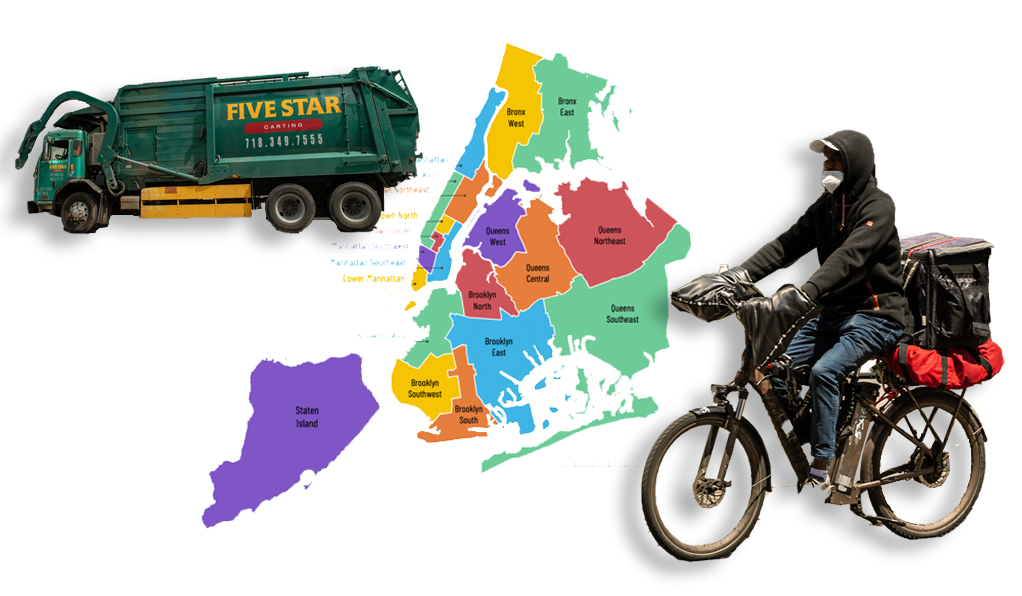Below is a letter from the Park Slope Civic Council to Mayor Bloomberg and local elected representatives regarding the City's plan to transform Sixth and Seventh Avenue's into one-way streets. It's lengthy but it's worth a read (and full disclosure: I'm a trustee of the Civic Council):
Park Slope Civic Council
March 7, 2007
Dear Elected Official,
As you know, last week, in a meeting at Borough Hall that included members of Community Board 6 and the Borough President's staff, Michael Primeggia, the Department of Transportation's Deputy Commissioner for Traffic Operations, unveiled a plan for a major reorganization of motor vehicle traffic through Park Slope. Details of the plan will be publicly released at a Community Board 6 Transportation Committee meeting on Thursday, March 15 at Methodist Hospital. Right now, what we know is this:
- Seventh Avenue between Flatbush and Prospect Avenues would be converted from a two-way street to a one-way southbound street.
- Sixth Avenue between Atlantic Avenue and 23rd Street would be converted from a two-way street to a one-way northbound street.
- On Fourth Avenue between 17th and Dean Streets, one travel lane would be removed in each direction and the Avenue's turning lanes would be improved.
Publicly, DOT is saying that this proposal is being made to improve pedestrian safety and "will have many benefits, including simplifying the turning movements at intersections to make it safer for pedestrians crossing the street and narrowing the travel lanes on Seventh Avenue to encourage vehicles to travel within the existing speed limit."
While the Park Slope Civic Council will reserve final judgment until after the details have been heard, several of you have contacted me asking for our initial reaction. The Civic Council is seriously concerned that the primary result of this plan will be to move more traffic through our neighborhood faster, not to improve pedestrian safety. You should also know that the response from neighborhood residents, many of whom have contacted us, as I'm sure they have you, too, has been overwhelmingly negative.
Our specifics concerns are:
This plan is about moving more traffic through the neighborhood faster.
One-way streets have a higher motor-vehicle carrying capacity than two-way streets. DOT's plan looks like it was designed to make up the loss of the two travel lanes being removed from Fourth Avenue by running more car and truck traffic along Sixth and Seventh Avenues. Since no one is much complaining about pedestrian safety on Sixth and Seventh Avenues, we believe the plan may in fact be a response to growing residential development on Fourth Avenue and the Atlantic Yards EIS, which proposes to eliminate the northbound half of Fourth Avenue between Atlantic and Flatbush.
One-way thoroughfares are less friendly to neighborhood life.
There is a great deal of evidence to suggest that the type of one-way avenues proposed are dangerous to pedestrians and harmful to communities:
- At a City Council hearing last week, DOT Commissioner Weinshall boasted of the traffic-calming benefits achieved in Downtown Brooklyn by "converting one-ways to two-ways."
- At the PSCC's transportation forum attended by hundreds of residents, there were many complaints about pedestrian safety and dangerous speeding problems on Eighth Avenue and Prospect Park West, both fast-moving one-way streets.
- USA Today recently reported that hundreds of towns and cities around the U.S. are converting their 1950's-era, one-way, through-traffic streets back to slower, more neighborhood- and business-friendly, two-way streets.
- The Pedestrian and Bicycling Information Center advocates two-way streets saying they slow traffic, allow better local access to businesses and homes, and eliminate the potential for higher speed, more dangerous crashes that exists on multi-lane, one-way streets.
- Two-way streets provide system redundancy and greater permeability. When a lane or street gets blocked off due to an accident or other problem there are more ways to get where you need to go if avenues are two-way.
The community was excluded from the planning process.
Notwithstanding the upcoming public meeting, we believe the community should have been consulted earlier in the planning process. Dozens of DOT's around the U.S. have rewritten their project delivery processes to include high levels of community input. New York City can and should be a leader in community-oriented design and planning and our elected leaders must advocate for this. The Park Slope community is prepared to work as a partner in planning the future of Downtown Brooklyn and surrounding neighborhoods. In fact, we are already doing it. We developed detailed, wide-ranging transportation planning feedback for the Atlantic Yards EIS. We co-founded the Grand Army Plaza Coalition to proactively re-envision the possibilities for this great public space and critical traffic junction. And last year we sponsored a transportation forum, which drew hundreds from around the neighborhood (DOT declined our invitation to attend).
Fourth Avenue can be transformed without increasing traffic in Park Slope.
In recent years, the idea has been put forward to transform Fourth Avenue into Brooklyn's great urban boulevard. We fully support the vision. If part of this vision involves narrowing Fourth Avenue, we believe that it can and must be done without shunting more traffic through nearby neighborhoods. DOT's traffic models often work under the assumption that any time a road is closed or narrowed, all of the traffic that was using that road will simply move to the next road over. For example, in the late '90s DOT's models predicted that closing Prospect Park to cars, even for just a few hours during weekdays would result in traffic cataclysm around the Park. Those predictions were wrong. DOT's traffic models did not account for the fact that when it becomes inconvenient to drive a certain way at a certain time, travelers may choose a different mode of transport, a different time of travel, or a different route.
There are clear pedestrian safety priorities in other parts of our neighborhood.
Two weeks ago, James Rice, a 4-year-old boy, was killed in the crosswalk while crossing, with the light, at Baltic Street and Third Avenue. He was holding the hand of his 18-year old aunt, who was injured. DOT has not followed through on Commissioner Weinshall's March 2004 commitment of $4 million to install traffic-calming measures at 101 intersections along Third Avenue by the end of fiscal year 2006. Not only have these traffic-calming measures not been completed, the work has not yet even begun. Most upsetting, the pedestrian safety measures planned for Third and Baltic are designed specifically to prevent the kind of "right-turn conflict" that killed James Rice. We call on DOT to implement the Downtown Brooklyn Traffic-Calming Plan.
We urge you, our elected officials, to do the following:
- Insist that the communities that will be affected by major transportation plans such as this be included in the City's planning processes. Including communities is a benefit to city government and, increasingly, is standard practice outside of New York City. Neighborhood stakeholders have fine-grained knowledge of needs and problems that no citywide official can possibly ever possess.
- Insist that changes like these only be considered as part of a comprehensive, multi-modal, area-wide transportation plan in response to the transformative development currently underway in and around Downtown Brooklyn. We have clearly reached a tipping point. The old solutions no longer work. Our area's rapidly increasing density means that we need to find effective ways to move local travelers and commuters out of their cars and into more efficient modes of transportation. Brooklyn's, and New York City's, future absolutely depends upon it. Shunting more traffic through one neighborhood street or another is not the solution.
- Insist on a plan that does not threaten but instead contributes to the neighborhood life that makes Brooklyn great.
We thank you for keeping the community's views front and center and we look forward to working with you to make sure that any traffic pattern changes implemented in Park Slope will have the full support of the community.
Sincerely,
Lydia Denworth
President
CC:
Mayor Michael Bloomberg
Borough President Marty Markowitz
Assemblymember Jim Brennan
Assemblymember Joan Millman
Senator Eric Andrews
Senator Velmanette Montgomery
Councilmember David Yassky
Councilmember Bill de Blasio
Community Board 6 Chair Richard Bashner





